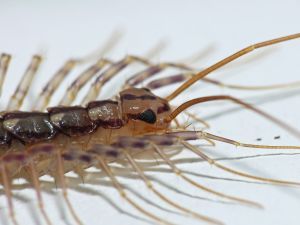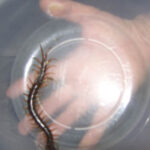Are you looking for random facts about centipedes for kids? Are you writing a science report about centipedes? Are you a home school mom preparing a lesson plan? Did your child just find a centipede and you would like to make a lesson out of it? Here are a few fun facts about centipedes for kids.
Centipedes have from 30 to 350 legs.
The amount of legs a centipede has varies on the species. But, centipedes usually have between 30 and 350 tiny legs.
Centipedes are not insects.
Some people mistakenly believe that centipedes are insects. However, they are not classified as insects because they have more than six legs. They are part of the arthropod family (that includes insects) and are in the myriapod class.
Each pair of legs is slightly longer than the pair in front of it.
The length of the centipede’s legs increase as you go down the centipede’s body. This prevents the centipede from stepping on his or her legs. It also helps them to move quickly in a special rhythm.
Centipedes are hunters.
Centipedes hunt for their food. They search for spiders, worms, flies and other insects to turn into a meal. Some of the larger centipedes will even eat slugs, snails and small lizards. Some centipedes will even eat prey that are as big as themselves.
Centipedes come in a variety of colors.
The majority of centipedes are brown, reddish-brown or yellow. However, in some places in the world, you can find centipedes that are blue, bright orange and red. Here is a short clip of a blue centipede.
Centipedes live in various locations.
The most common place for centipedes to live are forests around the world. However,they also reside in caves, deserts, gardens and grasslands. And, of course, there are some centipedes that live in homes.
There are more than 3000 different types of centipedes.
There are over 3000 different kids of centipedes. There might even be some out there in the world that etymologists (bug scientists) haven’t discovered yet.
Centipedes come in various sizes.
Some scientists are only an inch or two in length. However, some centipedes are much longer. In fact, the Peruvian giant centipede can be up to a full foot long. Click here to view a video of this fascinating creature.
Centipedes can travel up to 20 inches per second.
Centipedes move at different speeds, but some can go as fast as 20 inches per second. That is faster than many arthropods.
Some centipedes can live up to six years.
Centipedes live a long time compared to other arthropods. Some centipedes can live up to six years. Of course, in order to live that long, they must be very hidden from prey. Centipedes may take up to three years to be able to breed.
Centipedes have many enemies.
As centipedes do play an important role in the food chain, they are eaten by many animals. Some enemies of centipedes are birds, toads, shrews and frogs. Centipedes can try to defend and protect themselves by producing a sticky and smelly substance. They can also pinch their prey using their hind legs.
These are just a few random facts about centipedes. Searching for more trivia? Take a look at “Fun Facts for Kids About Grasshoppers” and “Facts for Kids About Mosquitoes.” You might also read “Fun Facts for Kids About Spiders.” Happy Learning!
SOURCES:
http://lancaster.unl.edu/pest/resources/centipedemillipede012.shtml
Centipede by Karen Povey
http://www.youtube.com/watch?v=uxypt-xp5PI






